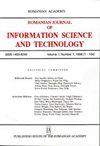将3D模型转换为语义Web表示
IF 3.9
4区 计算机科学
Q1 COMPUTER SCIENCE, THEORY & METHODS
Romanian Journal of Information Science and Technology
Pub Date : 2023-03-24
DOI:10.59277/romjist.2023.1.03
引用次数: 1
摘要
本文的目的是研究一种将X3D(可扩展3D)模型转换为RDF(资源描述框架)的基于规则的方法。转换是通过使用RDF映射语言(RDF Mapping Language, RML)来执行的。总结了它的优点,主要是由于所创建的规则建立了知识库。通过对其应用SPARQL (SPARQL协议和RDF查询语言)查询,指出了探索以验证和改进已定义的RML规则本身的可能性。本文考虑了一种以独特的方式从RDF三元组转换到原始X3D的方法,并对实现该方法所需的SPARQL查询类型进行了系统化。为X3D模式中定义的所有元素制定了规则,并描述了它们的属性和属性。它们的可访问性得到了保证。从X3D模型到RDF的转换被证实符合在Web上创建可访问、可理解和可重用本体的指导方针和最佳实践。检查用于从RDF三元组转换到原始X3D的系统化SPARQL查询类型,以查找特定元素和示例数据,获得的结果确定其正确性。说明了所述方法的先决条件和限制。建议的方法允许构建一个全面的知识库,其中包括RML规则、转换后的X3D模型和特定于领域的本体,以及用于分析数据和语义推理的本体。包含3D内容的电子图书馆可以从本研究中讨论的解决方案的好处和可能的未来应用中获益。”本文章由计算机程序翻译,如有差异,请以英文原文为准。
Transforming 3D Models to Semantic Web Representation
"The purpose of the present paper is to research a rule-based approach for transforming X3D (eXtensible 3D) models to RDF (Resource Description Framework). The transformation is performed by using the RDF Mapping Language (RML). Its advantages are summarized, which are mainly due to the fact that the rules created build a knowledge base. By applying SPARQL (SPARQL Protocol and RDF Query Language) queries to it, the possibility of explore in order to validate and improve the defined RML rules themselves, is pointed out. An approach for reversing from the RDF triples to the original X3D in a unique way is considered, and the types of SPARQL queries needed for its implementation are systematized. Rules are formulated for all elements defined in the X3D schema, their attributes and properties are described. Their accessibility is ensured. The conversion of X3D models to RDF is confirmed to be consistent with guidelines and best practices for creating accessible, understandable, and reusable ontologies on the Web. The systematized SPARQL query types for reversing from RDF triples to the original X3D are checked for specific elements and sample data, and the obtained results establish their correctness. The prerequisites and limitations of the represented approach are explained. The proposed approach allows building a comprehensive knowledge base that includes the RML rules, the transformed X3D models and the domain-specific ontology and its use to analyzing data and semantic reasoning. The electronic libraries that include 3D content could take advantage from the benefits and possible future applications of the solutions discussed in this study."
求助全文
通过发布文献求助,成功后即可免费获取论文全文。
去求助
来源期刊

Romanian Journal of Information Science and Technology
工程技术-计算机:理论方法
CiteScore
5.50
自引率
8.60%
发文量
0
审稿时长
>12 weeks
期刊介绍:
The primary objective of this journal is the publication of original results of research in information science and technology. There is no restriction on the addressed topics, the only acceptance criterion being the originality and quality of the articles, proved by independent reviewers. Contributions to recently emerging areas are encouraged.
Romanian Journal of Information Science and Technology (a publication of the Romanian Academy) is indexed and abstracted in the following Thomson Reuters products and information services:
• Science Citation Index Expanded (also known as SciSearch®),
• Journal Citation Reports/Science Edition.
 求助内容:
求助内容: 应助结果提醒方式:
应助结果提醒方式:


